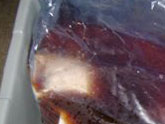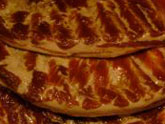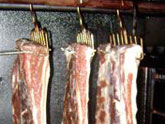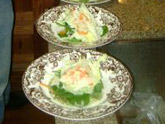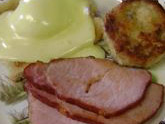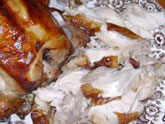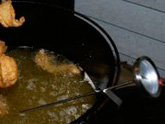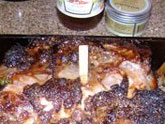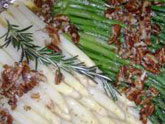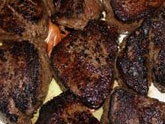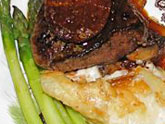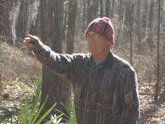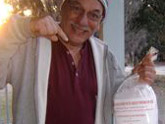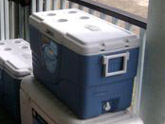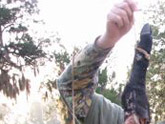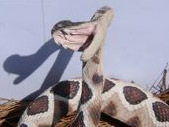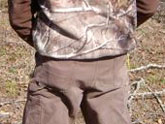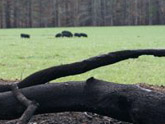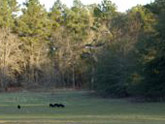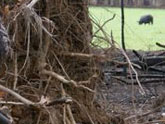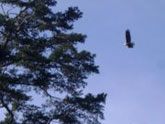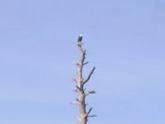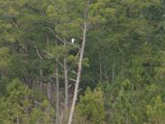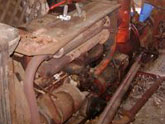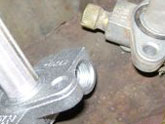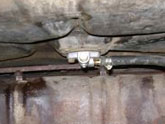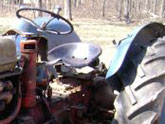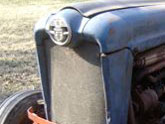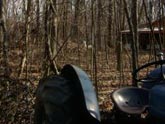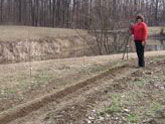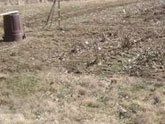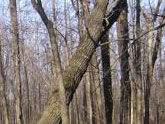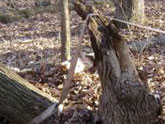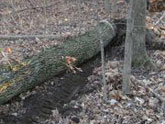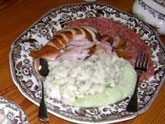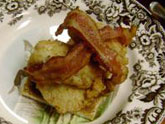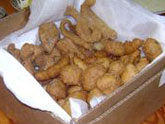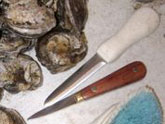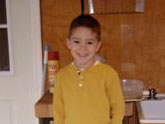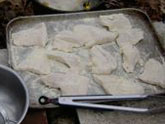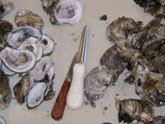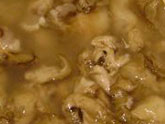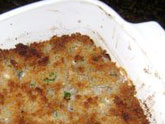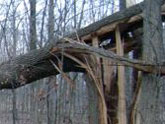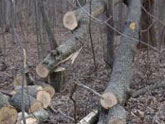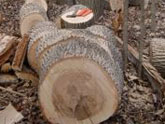March 30, 2009
Makin' Bacon
Eight years ago while installing a hasp on a new upright freezer to keep the door from popping open, I drilled through a refrigerant coil on the last screw hole. What to do but strip the freezer and upgrade the carcase to a smoker for hams, chickens, fish, cheese, sausages and bacon? Until then, I'd been using a small manufactured unit, looking to get bigger.
Smoking bacon doesn't require work so much as time and some attention. I monitored these three bellies during a week of woodcutting. Five days marinating at 38º in a sweet apple cider brine infused with aromatics, overhauling them occasionally, and then two days in the smokehouse over a schedule of temperatures and hickory smoke.
Janet Conklin at Delaware Meats saves fresh sides for me when meaty ones come through the slaughterhouse. I usually prefer working 4 to 6, but she only had 3 this time. Good enough to run a batch.
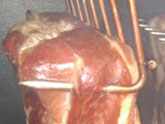 |
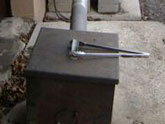 |
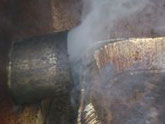 |
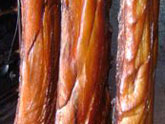 |
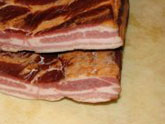 |
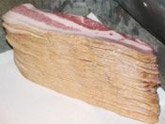 |
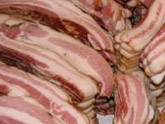 |
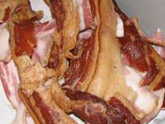 |
March 24, 2009
Pig Hunt, March 1-7, Conclusion
Each of us is responsible for an evening meal at Milston, and we try to make it memorable. Monty Browning has contributed several that stand out. One featured cubed and breaded venison round steaks, seasoned with Cavenders and pan fried, with gravy. Another was a blackened venison loin. Served with his signature mashed potatoes, it was a hot iron-skillet affair complemented by a superb glaze. That dinner was so good, that Chief nicknamed him Chef Mon-tay.
To the other end of the spectrum, Darryl Quidort put together a dinner that still makes us laugh years afterwards. He tried to defer to others, claiming cookstove incompetence, offering to clean kitchen for the duration instead, but ritual is ritual. When we came in from hunting, we sat down to a beef stew that included tiny perfect cubes of carrots and potatoes, and uniformly shaped dumplings. After dinner, I found where Darryl had dug to the bottom of a 45 gallon waste barrel to hide the evidence—empty cans of Dinty Moore and two sleeves of Betty Crocker biscuits. That meal earned Darryl a dishtowel and dropped him from the rotation.
Mary once observed that we progress with food through three levels. We begin concerned that our table has enough food for everyone. From there we work toward its quality, its taste. Finally, we concern ourselves with its presentation, with how it looks. Chief Dan Hugelier is one of only about 60 Certified Master Chefs in the United States. He's raised the bar since he started coming to Milston. He makes beautiful food. It's good. We eat 'til we fall over.
-------------
Advocates of the game elevate golf as an important tool of business because it reveals character. In fact, doesn't all adversity reveal character? Don't we gain a larger revelation from questioning our attraction to a fabricated game played in an artificial environment according to arbitrary rules? It's not how we play golf that reveals us, but that we play it.
Put men together in hunting camp. Loose them upon Natural Creation to be hunters of meat by means of their choice, as it has always been. Free them with no witness beyond their God to their conduct. Let them deal with their mistakes against the judgment of ageless laws and immutable rules. Have them face the moment of truth with nothing more than the strength of their own bone, sinew and nerve to effect its outcome. No one hides in hunting camp. Not even from themselves.
One Milston is solitary and the other is social. Each clarifies and enriches the other.
March 23, 2009
Pig Hunt, March 1-7, part 4
Cliff "Spike" Huntington, gained the sobriquet Spike the Knife when he walked up behind a large, bayed, wounded hog in the Milston swamp, grabbed its hind leg with one hand, flipped it over, and with his knife hand found its heart's blood. There is more legend to Spike than truth, and that pleases him. He is the cagey veteran of Milston, the trap-wise coyote missing a few toes. "No way Spike is going to look in a cooler," Stanley said. "He's too smart for that."
"Here's what we'll do," Robert said. "Take the snake out of Stanley's cooler and rig it in the ice cooler on the porch. When Spike and I go fishing tomorrow after lunch, I'll ask him to grab a bag of ice for the boat."
"Great," said Stanley. "I'll set up nearby to photograph his reaction." So that night, when Spike wasn't looking, we rigged up the snake in a cooler identical to the ice chest and set it on the porch floor near its twin.
That morning, I added camouflage to the trap. I invited Spike out onto the porch to photograph me holding a bag of ice from the ice chest, explaining to him that it concerned a private joke between Mary and myself. The trap was set when we moved the ice chest to the floor where the snake had been, and substituted the snake chest while Robert and Spike prepared to go fishing. Stanley took a position on the porch in a nearby rocking chair, fiddling with his camera, and I took up observation behind a window in the lodge.
Robert sent Spike on his errand. He marched up the steps, came to the coolers, walked past the trap, reached into the cooler on the floor without hesitation, and grabbed a bag of ice. Down he marched and into Robert's car to go fishing. Our jaws dropped. Wrong damn cooler. Did he forget where the ice was?
Robert made a discreet circle motion to Stanley, and he and Cliff rode off. Stanley quickly switched the coolers, moving the snake to the floor and the ice back to its original position atop the white cooler, then resumed his seat in the rocker. As they drove off, Robert told Spike that they probably needed another bag of ice for the boat cooler, so they did a U turn and came back. Spike strode up the steps, over to the coolers, reached into the top one, looking neither left nor right, pulled out a bag of ice, returned to the car and went fishing.
Dagger in the heart of the conspirators, and we turned on one another. Stanley suggested that Spike was either the dumbest, luckiest cluck in the world, or shrewd beyond comprehension. Robert complained that I gave the ruse away with the photograph session. I blamed Chief for spilling the beans. The swamp isn't the only perilous place at Milston.
March 22, 2009
Pig Hunt, March 1-7, part 3
Stanley is a dentist by vocation and a school boy by heart, 3rd grade. He rigged the cooler with the rubber snake in it, attached by a short monafilament line to its head on one end, and to the lid on the other, so that when you lifted the lid, the snake rose up from its nest of pine needles. It was also his camera that found glee in capturing grown men peeing in the woods. And it was his camera and his voice behind it that goaded an old man onto a table top for a thirty yard broadhead shot at an ethafoam deer target, when a miss meant an arrow buried in a tree trunk. It was his tailgate set-up, too, that captured Mike Huston and Chief Dan reacting like Nancy boys to a harmless rubber snake. Shameful all around.
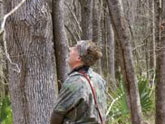 |
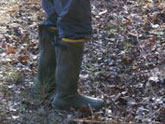 |
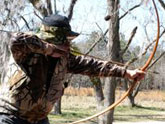 |
March 21, 2009
Pig Hunt, March 1-7, part 2
Chief had the first week of March free, so that's when we scheduled our pig hunt. Bad timing and further proof that work should never interfere with hunting. The pigs had picked a sparse fall mast crop clean, so most of them left the swamp hardwoods several weeks before our arrival to feed in the green fields. Since it was early in the growing season, and since they were hungry, the fields resembled over-grazed pastures. You can't sneak within the 20 yard comfort zone archers require when you have no cover.
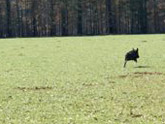 |
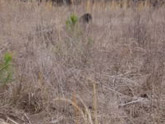 |
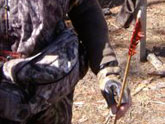 |
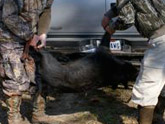 |
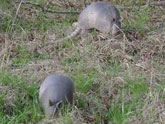 |
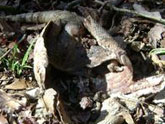 |
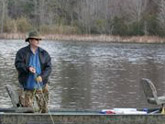 |
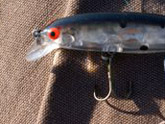 |
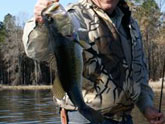 |
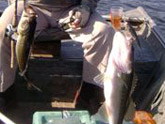 |
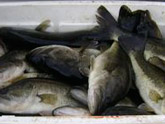 |
Last year, during our hunt in May, the knee-high wheat fields where the pigs fed obscured a hunter's careful movement. The hunt before that, in January, a heavy mast crop kept the pigs within the ideal stalking conditions of the swamp. This year, because of the situation, I fished as much as I hunted. The pig hunting was still good enough that Chief elected to stay after them, but the bass fishing was better, and that's where Robert, Stanley, Spike and I turned much of our attention. The bass had their pre-spawn feed bag on, and were churning up schools of shiner minnows.
March 18, 2009
Pig Hunt, March 1-7, part 1
Parts of Low Country Swamp along the Savannah River in South Carolina have changed little since Maurice Thompson stalked through them with his longbow over 100 years ago. The Ivory Bills that he loved may be absent, but no chem trails carve up the sky, no small planes drone overhead, no roadway traffic competes with the songs of peepers and birds, squirrels show little fear of humans, and nothing beyond the direction of the wind, or the depth of swamp water, or the noise that a sounder of feeding pigs makes, determines the hunting archer's course through palmetto fronds, clumps of switch cane and tall diverse hardwood trees with huge, swollen bases.
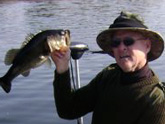 |
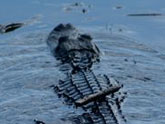 |
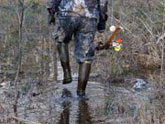 |
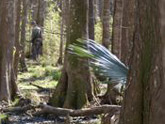 |
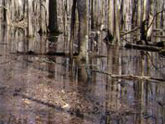 |
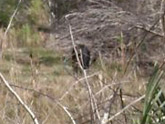 |
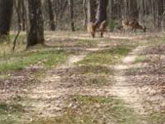 |
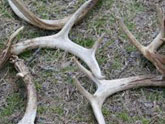 |
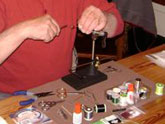 |
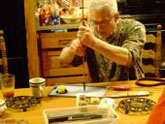 |
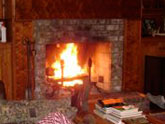 |
I've had the good fortune to wander the Low Country at Milston Plantation sometimes several times a year for 12 years now, and to experience a quality of hunting and fishing such as sportsmen dream of. Another Milston exists alongside the wilderness. It's comprised of the handful of characters who first invited me, and who gather there when I come. One Milston is solitary and the other is social, but each clarifies and enriches the other.
March 17, 2009
Making Repairs
My father-in-law valued shop manuals. Mary remarked once that they were Keats and Shelley to him. If he owned a machine with a motor of any sort attached to it, he had a shop manual for it. He made sure I had them for my equipment, too, even when it meant mailing to the manufacturer. Shop and service manuals empowered him, enabling him to make repairs on anything he owned. His pride and independence were a common ethic and characterized his generation. Today, indifference and indolence turn us into strangers traveling in a foreign land, beholden to hired translators and tour guides to shepherd us along.
I thought about him when I broke out the Ford 800 Tractor shop manual. The shutoff valve directly under the gas tank was dripping gas onto the valve cover, its packing shot. He would have set to removing the hood assembly and the gas tank to get to the valve with the devotion of a Pilgrim intent on heaven, and would have probably tried some way to repack it, too, just for extra spiritual credit. I drove 50 miles one way, south of Columbus, to purchase a new one.
The 800 was built in the 50's. It's a solid tractor, conceived for the long haul. Mine wouldn't pose up on a suburban lawn and suggest prosperity. It makes a different sort of brag, and I like it.
March 15, 2009
Early Garden
Every March a short span occurs when the ground warms and dries enough for planting early garden. Passing the opportunity can mean a month's delay or more if cold rains come. I switched from firewood mode this afternoon and planted two short rows of Bloomsdale spinach, a short row each of Buttercrunch butter head lettuce and Black-Seeded Simpson loose leaf lettuce, and a long row of Norland red potatoes. No sweet peas this year. That's good for now.
It's difficult for me to do much garden prep in the Fall, to clear tomato cages and vines, haul out and spread chicken manure and compost, till the garden, plant a green cover crop and have everything, including machinery and tools, poised for spring planting because a stronger, more urgent call comes from the timber. The garden phase by then turns to canning fruits and vegetables, and the rest of my time is spent chasing whitetail deer and squirrels, or heading south to the swamp, or west for elk or something similar, somewhere, with bow in hand.
So, with no more preparation for this window than its anticipation by the purchase of seed last week, it was heartening to have the garden tiller fire up with little encouragement. I knocked light rust off the rake and the hoe, and thought about green beans and new potatoes.
March 14, 2009
Widow makers
Felling trees and cutting firewood is dangerous business. One of the more dangerous situations is the classic widow-maker tree, the tree that falls against other trees. I've cut plenty of these down incorrectly, by bucking them from underneath. I've also done other stupid things and survived.
This section of ash was a top log that busted out during heavy winds. Its branches were caught in a large shagbark hickory. I decided to bring it down safely with the tractor, but the base had dug into the ground so deep that the old Ford 800 couldn't budge it.
Mary watched my labors, laid a finger aside her cheek and in a thoughtful manner suggested using a nearby four foot section of log as a fulcrum to lift the butt from the ground. Genius. I laid the strap over the fulcrum section, leaned it back toward the widow-maker, propped it there with a stick, and gunned the tractor. The butt lifted from its pocket and the tree pulled down according to plan, plowing a furrow for the duration of the drag.
March 13, 2009
Oysters and Fish
Mike Huston joined us at our pig hunt in South Carolina last week. He brought a gallon of fresh oysters, a bushel of oysters in a burlap sack, four short lengths of lighter wood, and a young cur hog/stock dog that he hoped to leave with one of us. We ate the gallon there, and I brought the bushel of oysters and the lighter wood home.
Mike gave me another bag several years ago when he came to Ohio for a deer hunt. I have oyster knives from both Mike and Chief, and can use them with sufficient dexterity that I'm looking forward to the next bag. Simple shucking techniques followed in sequence speed the process. Hold the oyster so the flat shell is on top, the cupped half down, and address the hinge with the point of the knife. Twist to pry open, push the knife in maintaining contact with the roof of the flat shell and sever the attached muscle. Toss the shell aside and probe under the oyster to sever the corresponding muscle attaching the oyster to the cup half of the shell, being careful all the while to keep everything level enough that the liquid does not spill. Inspect for any chips of shell, or excessive oyster mud, which are moved aside with the knife, and so on to the next.
Since my return, we have had oysters on the half shell, with Louisiana Hot Sauce; dusted with Zatarain's Fish-Fry and deep fried; floured lightly, dipped in egg wash, breaded and deep fried; and oyster soup, twice, with half-cream, butter and Trader Joe's Oyster Crackers. Tomorrow, Mary will bake Oysters Rockefeller with the remaining dozen. That's a good way to go out.
My grandson Varmint and his family came here Sunday, the first day of my return, for a fish and oyster fry. With spring on the way and the danger of a deep freeze minimal, I turned on the water in the outside sink and called him out to assist with the oysters. He scrubbed while I shucked. Actually, I scrubbed them before he came out. He went over them again in case I missed anything. His help slowed my progress, but his questions and comments were rich compensation.
March 10, 2009
Firewood
A wind approaching 70 mph knocked down enough trees in our woods a month ago to supply us with firewood for 2010 once we add them to the several dead ones standing on stump. It's been slow progress cutting them up. First too much snow, then chain saw problems.
The little 12" Stihl quit pumping oil to the bar and it's been an ordeal getting it functioning again. Found out I couldn't myself replace the $30 oil pump I purchased without also having an $80 extraction tool, and a $200 installation tool. Found out also that an authorized repair dealer where I left the saw for a week did not have the tools either, and decided not to invest in them.
Just back from pig hunting and fishing in South Carolina, and anxious to make up time on the firewood stack, but not about to use the heavy 20" Stihl for cutting top logs and limbs into 18" lengths.
I'll need at least 6 trees cut, split and stacked in the woodshed before it warms up, and I'm still working on the first one. Gotta get busy.


